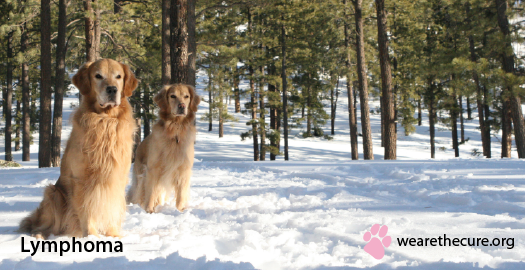Lymphoma is the Most Common Dog Cancer
What is Lymphoma?
Malignant lymphoma or lymphosarcoma is one of the most common neoplasms (tumor) in dogs. They usually originate in lymphoid tissues, like the lymph nodes, spleen, and bone marrow. However, they can arise in any tissue in the body. Lymphoma accounts for approximately 7-24% of all canine neoplasia (formation of new tissue) and 83% of all canine hematopoietic (blood cells) malignancies.
Lymphoma is generally seen in middle-aged to older dogs (median age, 6-9 years). Breeds that are believed to have a higher incidence of lymphoma include Boxers, Bull Mastiffs, Basset Hounds, Saint Bernards, Scottish Terriers, Airedales, and Bull dogs. Dogs with a lower risk include Dachshunds and Pomerians. Neutered females tend to have a better prognosis.
Stages of Lymphoma
World Health Organization (WHO) has classified different stages of lymphoma based on its degree of metastasis and invasiveness. They are as follows:
- Stage I: Ailment restricted to a single lymph node.
- Stage II: Regional lymphadenopathy (restricted to one side of the diaphragm).
- Stage III: Generalized lymphadenopathy (enlargement of lymph nodes)
- Stage IV: Enlargement of the liver and spleen or hepatosplenomegaly (with or without lymphadenopathy)
- Stage V: Bone marrow, CNS (Central Nervous System), or involvement of other extra-nodal sites
 Obviously, the sooner your dog has been diagnosed the better the chance of survival as the disease progresses health effects get more and more severe. Testing for lymphoma is typically done with fine needle aspiration but is often accompanied by a battery of tests such as blood and urine tests, X-rays, and sonograms.
Obviously, the sooner your dog has been diagnosed the better the chance of survival as the disease progresses health effects get more and more severe. Testing for lymphoma is typically done with fine needle aspiration but is often accompanied by a battery of tests such as blood and urine tests, X-rays, and sonograms.
What Causes Lymphoma in Dogs?
The causes are not understood and probably involve both genes and the environment. Genetic mutations and chromosomal aberrations (change in the normal structure of DNA) have been reported in canine lymphoma, and most of the DNA changes appear to be acquired throughout the dog’s life. Although certain viruses have been associated with some lymphomas in people, that has not been established in dogs.
In both people and dogs, certain environmental factors are believed to trigger the disease. People and dogs living in industrial areas have an increased risk of lymphoma. Moreover, household use of the herbicide 2,4-D and storage of paints and solvents were also risk factors for lymphoma in dogs. One study found that living within 10 miles of a nuclear power plant, or within 2 miles of a chemical supplier or crematorium were possible risk factors.
A weak immune system has also been identified in dogs with lymphoma.
How Many Types of Lymphoma are There in Dogs?
There are basically 5 types of Lymphoma:
- Alimentary Lymphoma – Occurs in the gastrointestinal tract of dogs. It can become fatal if the tumor is situated near the small or large intestine, since it can restrict bowel passage and pose health hazards.
- Cutaneous Lymphoma – A form of skin cancer that originates anywhere in the dermal layers of a canine’s skin and can take the form of reddened lumps that can be itchy and cause discomfort in your pet.
- Extra Nodal Lymphoma – The rarest among all lymphomas, this type can affect areas like breast tissue, cutaneous tissue (skin), hepatic tissue (liver), ocular or orbital tissue (eyes), osteo tissue (bone) and oral tissue (mouth).
- Mediastinal Lymphoma – Usually develops in the lymphoid tissues of the chest. They are present around the cardiothoracic region. If left untreated, they can restrict the function of the lungs, resulting in death.
- Multi-centric Central Nervous System Lymphoma – Affects the external lymph nodes, but in a vast majority of cases, it has been observed that lymphoma eventually invades the organs and the healthy tissues are replaced by the diseased ones.
How is Canine Lymphoma Treated?
The most common treatment for canine lymphoma is chemotherapy. Other methods like surgery or radiation therapy can be advised by veterinarians based on the dog’s condition. Canine lymphoma chemotherapy costs can range between $1,000 – $10,000 with an average cost of about $5,000.
 Thank you for utilizing our Canine Cancer Library. Please help us keep this ever-evolving resource as current and informative as possible with a donation.
Thank you for utilizing our Canine Cancer Library. Please help us keep this ever-evolving resource as current and informative as possible with a donation.
References
Tumors in Domestic Animals- Donald J. Meuten, DVM, PhD, is a professor of pathology in the Department of Microbiology, Pathology, and Parasitology at the College of Veterinary Medicine, North Carolina State University, Raleigh
Withrow and MacEwen’s Small Animal Clinical Oncology– Stephen J. Withrow, DVM, DACVIM (Oncology), Director; Animal Cancer Center Stuart Chair In Oncology, University Distinguished Professor, Colorado State University-Fort Collins, Colorado;
David M. Vail, DVM, DACVIM (Oncology) Professor of Oncology, Director of Clinical Research, School of Veterinary Medicine University of Wisconsin-Madison Madison, Wisconsin
Other Articles of Interest:
Blog: Tanovea – FDA Approved Drug for Lymphoma Treatment
Blog: How To Help Pay For Your Dog Cancer Treatment Cost: 7 Fundraising Ideas
Blog: What Are Good Tumor Margins in Dogs and Why Are They Important?
Blog: Dispelling the Myths and Misconceptions About Canine Cancer Treatment
Blog: Financial Support for Your Dog’s Fight to Beat Cancer
Blog: Cancer Does Not Necessarily Mean A Death Sentence
Blog: What To Do When Your Dog Is Facing A Cancer Diagnosis – Information Overload
Blog: Dog Cancer Warning Signs: Help! I Found a Lump on My Dog
Common Chemotherapy Side Effects



Recent Comments